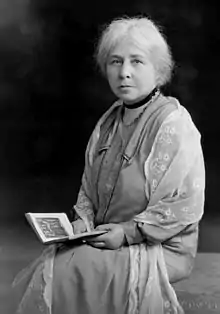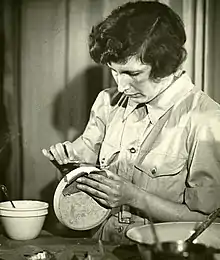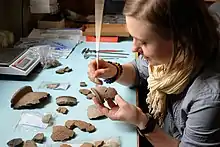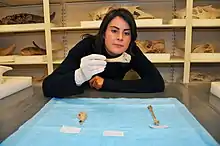Women in archaeology
Women in archaeology is an aspect of the history of archaeology and the topic of women in science more generally. In the nineteenth century women were discouraged from pursuing interests in archaeology, however throughout the twentieth century participation and recognition of expertise increased. However women in archaeology face discrimination based on their gender and many face harassment in the workplace.

History

As a professional field of study, archaeology was initially established as an academic discipline in the nineteenth century and typically developed from people engaged in the study of antiquities.[1][2] Prior to the Victorian era, women in Canada, the United Kingdom and the United States were rarely engaged in professional archaeology (though at this time, archaeology was not so much a profession as the practice of wealthy individuals, with workers paid to undertake the digging).[3] Participation by women in the field was discouraged, both by men and societal pressure, as the occupation masculinized the accepted view of women as homemakers and nurturers.[4] Even after they began to enter the field, the reluctance of male colleagues to accept them in fieldwork, led many women to choose roles outside of academia, seeking positions in museums or in cultural preservation associations.[5] In Europe, women often entered the discipline as research partners with their husbands or to learn about the cultures when their spouses were posted to Colonial outposts or missionary fields.[6] From the mid-1850s women's higher education facilities began offering separate courses for women and in the 1870s several European countries opened university curricula to women.[7] Though women were accepted into the study of archaeology, they were rarely considered equals and often were not admitted to prestigious societies,[8] or allowed to complete training in the field. Swedish archaeologist Hanna Rydh was one exception,[9] as was French archaeologist Madeleine Colani,[10] but more typical were the hard-fought battles of women such as Edith Hall, Harriet Boyd Hawes, Marina Picazo, Eugénie Sellers Strong, and Blanche E. Wheeler to undertake excavation projects.[9] More typically, women such as German archaeologist Johanna Mestorf, who worked as a museum curator and academic;[11] writers such as British Egyptologist Amelia Edwards and [12] Persianist Gertrude Bell,[10] and French Persianist Jean Dieulafoy, who traveled and wrote about excavations during their travels; and women like Tessa Wheeler, who assisted her husband by compiling reports and raising money, were the pioneers of women archaeologists.[13]
At the turn of the twentieth century, British women such as Eugénie Sellers Strong, who taught at the Archaeological Institute of America and British School at Rome and Margaret Murray, who lectured at University College London, began to join the ranks of university staff.[10] By the time of World War I, the majority of women working in the archaeology were employed in museums. Noted women archaeological curators or museum directors include Dane Maria Mogensen, Greek Semni Karouzou and Spaniards Concepción Blanco Mínguez and Ursicina Martínez Gallego[14] To carve out their own niches, women typically focused on research close to where they lived or from their native cultures, or undertook studies researching household items typically ignored by men. For example, Marija Gimbutas focused on Eastern European topics even after relocating to the United States;[15] Lanier Simmons, who wanted to study Maya culture, ended up researching closer to home because of family obligations;[16] and Harriet Boyd focused on domestic objects and utensils.[15] Greek Anna Apostolaki, Dane Margrethe Hald, Spaniard Felipa Niño Mas and Swede Agnes Geijer became experts on textiles; Dane Elisabeth Munksgaard focused on clothing,[17] while Norwegian Charlotte Blindheim studied Viking costumes and jewelry.[18] Pottery and art were also topics on which women focused.[17]
Prior to the 1970s, even women like Gertrude Caton-Thompson, Hilda Petrie, and Elizabeth Riefstahl, pioneers in Egyptology who had made distinguished contributions to the field, were omitted from compilations of experts working in the field. If women were mentioned at all, their roles were trivialized.[19] During the New Deal, the Works Progress Administration sponsored excavations at mound sites in Alabama, Georgia and North Carolina, which allowed women of color and working-class women to participate in archaeological work; however, class- and race-based definitions of femininity curtailed broad participation by white women, who tended to focus on participating in amateur organizations.[20]
Archaeological conservation

The formal conservation of archaeological objects in Western museum environments from the 1880s onwards was dominated by male scientists and technicians. However, conservation of objects in the field and in educational settings was predominantly performed by women, often the wives and relatives of male archaeologists. Similarly to female archaeologists, these expert contributions to archaeological practice were omitted from official publications and records of archaeological work undertaken.
The expertise of early female conservators was then applied and refined at the Institute of Archaeology at St John's Lodge, Regents Park, from 1937 to 1959. When the Institute of Archaeology moved to Gordon Square in 1959, a conservation teaching programme was established by Ione Gedye who continued to teach at the institute from 1937 to 1975.[21]
The objects treated at the Lodge formed the basis of the Institute of Archaeology collections, including the Petrie Palestine collection.[22] These collections were instrumental in establishing the Institute of Archaeology as an internationally significant centre of archaeological study.
Contemporary issues
History of women in the discipline
Critically analyzing the role of women in archaeology from the professionalisation of the discipline in the 19th century to the present day is a crucial task to undertake. Although there are some publications on the subject, it can be said that in general we know little about it, and that the absence of women in the histories of archaeology should lead us to reflect urgently on the way disciplinary chronicles are written.[23]
Glass ceiling
Statistics show that women experience a glass ceiling in academic archaeology. Sue Hamilton, the director of the UCL Institute of Archaeology, noted that 60–70% of the institute's undergraduate and postgraduate students were women, as were the majority of its postdoctoral researchers. However, the proportion of women amongst permanent academic staff has never been more than 31%. Women are progressively further under-represented in each academic rank at the institute: 38% of lecturers are female, 41% of senior lecturers, 17% of readers, and just 11% of professors.[24] A 2016 study found a similar pattern in Australian universities. Whilst 41% of academic archaeologists were women, there was an imbalance in female representation in research fellowships (67%) compared to higher-ranked lecturing posts (31%). This study identified a "two-tiered" glass ceiling: women were less likely to obtain permanent tenure-track positions, and those that did also found it more difficult to advance to senior ranks.[25] In 1994, around 15% of the archaeologists working in the top 30 academic institutions for the field were women.[26]
On the other hand, it was within academic archaeology that women first broke the glass ceiling at a number of British universities. Dorothy Garrod was the first woman to hold a chair (in any subject) at either the University of Cambridge or the University of Oxford, having been appointed Disney Professor of Archaeology at Cambridge in 1939.[27] Kathleen Kenyon was acting director of the Institute of Archaeology, University of London, during the Second World War. Rosemary Cramp was the first woman to hold a chair at the University of Durham, having been appointed Professor of Archaeology in 1971.[28][29]
Sexual harassment and assault
In 2014, the Survey Academic Field Experiences (SAFE) surveyed nearly 700 scientists on their experiences of sexual harassment and sexual assault during fieldwork. The survey was aimed at field researchers across a range of disciplines (e.g. anthropologists, biologists), but archaeologists constituted the largest group of respondents. The survey confirmed that sexual harassment and assault were "systemic" problems at field sites, with 64% of respondents reporting that they had personally experienced harassment and 20% that they had personally experienced sexual assault. Women, who made up the majority of the respondents (77.5%), were significantly more likely to have experienced both and were also more likely to report that such experiences were occurred "regularly" or "frequently". The targets were almost always students or early career researchers, and the perpetrators were most likely to be more senior members of the research team, although harassment and assault from peers and members of local communities were also relatively common. The experiences reported ranged from "inadvertent alienating behavior" to unwanted sexual advances, sexual assault and rape. Few respondents found that there were adequate codes of conduct or reporting procedures in place. The authors of the SAFE survey emphasised the significant negative impacts that such experiences of have on victims' job satisfaction, performance, career progression, and physical and mental health.[30]
Notable women archaeologists
- Linda Braidwood (1909–2003), United States, Near Eastern Archaeology[31]
- Gertrude Caton-Thompson (1888–1985), United Kingdom, Egyptologist[19]
- Grace Crowfoot (1879–1957), United Kingdom, archaeological textiles[32]
- Frederica de Laguna (1906–2004), United States, Native Alaskan cultures[33]
- Caroline Dormon (1888–1971),[5] United States, indigenous peoples of Louisiana[34]
- Edith Hall Dohan (1877–1943), United States, Etruscan and Mediterranean civilizations[35]
- Cecily Margaret Guido (1912-1994), United Kingdom, prehistoric settlements[36]
- Harriet Boyd Hawes (1871–1945), United States, Minoan and Mediterranean cultures[37]
- Dorothy Cross Jensen (1906–1972),[5] United States, Iraq and indigenous peoples of New Jersey[38]
- Semni Karouzou (1897–1994), Greece, Classical Archaeology[39]
- Mary Butler Lewis (1903–1970), United States, Hudson Valley[5]
- Margaret Murray (1863–1963), India/United Kingdom, Egyptologist[32]
- Hilda Petrie (1871–1957), Ireland, Egyptologist[32]
- Dorothy Popenoe (1899–1932), United Kingdom, Honduran Maya and Pre-Columbian era[5]
- Tatiana Proskouriakoff (1909–1985), Russia/United States, Guatemalan and Mexican Maya[40]
- Elizabeth Riefstahl (1889–1986), United States, Egyptologist[19]
- Doris Stone (1909–1994), United States, Costa Rican and Honduran prehistory[41]
- Marian E. White (1921—1975), United States, Erie people, Neutral Nation, Wenrohronon[5]*+
- Sara Yorke Stevenson (1847–1921), United States, Egyptology and Near East
- Zheng Zhenxiang (b. 1929), China, Shang dynasty[42]
- Marija Gimbutas (1921–1994), Lithuania/United States, Neolithic and Bronze Age cultures of Old Europe and Kurgan hypothesis
Gallery
References
Citations
- Díaz-Andreu 2007.
- Díaz-Andreu & Sørensen 1998, p. 11.
- Cohen & Joukowsky 2006, p. 1.
- Claassen 2000, p. 173.
- Claassen 1994, p. 4.
- Díaz-Andreu & Sørensen 1998, p. 4.
- Díaz-Andreu & Sørensen 1998, p. 5.
- Díaz-Andreu & Sørensen 1998, p. 7.
- Díaz-Andreu & Sørensen 1998, p. 8.
- Díaz-Andreu & Sørensen 1998, p. 14.
- Díaz-Andreu & Sørensen 1998, pp. 12–13.
- Díaz-Andreu & Sørensen 1998, p. 13.
- Díaz-Andreu & Sørensen 1998, pp. 13–14.
- Díaz-Andreu & Sørensen 1998, pp. 15–16.
- Díaz-Andreu & Sørensen 1998, p. 9.
- Claassen 1994, p. 131.
- Díaz-Andreu & Sørensen 1998, p. 10.
- Díaz-Andreu & Sørensen 1998, p. 113.
- Cohen & Joukowsky 2006, p. 5.
- Claassen 1994, p. 6.
- Pye, Elizabeth; Brommelle, Norman (January 1977). "A Tribute to Ione Gedye". The Conservator. 1 (1): 3–4. doi:10.1080/01400096.1977.9635631. ISSN 0140-0096.
- Odegaard, Nancy (2016). The Conservation Practices for Archaeological Ceramics of Sir Flinders Petrie and Others between 1880-1930. ICOM-CC. ISBN 978-83-64419-80-5.
- ArqueólogAs.
- Hamilton 2014.
- Smith & Burke 2016.
- Claassen 1994, p. 5.
- Smith, Pamela Jane (1996). "Dorothy Garrod, first woman Professor at Cambridge". Antiquity. 74 (283): 131–136. doi:10.1017/S0003598X00066230. S2CID 163187954.
- Addicott, Ruth (11 July 2011). "Digging detective". The Northern Echo. Archived from the original on 31 March 2014. Retrieved 31 March 2014.
- "Six Groundbreaking Female Archaeologists". English Heritage. Retrieved 15 February 2021.
- Clancy et al. 2014.
- "Linda Braidwood, 1909-2003". www-news.uchicago.edu. Retrieved 2019-11-14.
- Cohen & Joukowsky 2006, p. 6.
- Claassen 1994, pp. 5, 12.
- Lee 2009, p. 263.
- Claassen 1994, pp. 5, 47.
- "Peggy Guido [Obituary]". The Times. 30 September 1994. p. 19.
- Claassen 1994, pp. 5, 44.
- Ferguson 1997, p. 261-626.
- Nikolaidou, Marianna; Kokkinidou, Dimitra (1998). "Greek Women in Archaeology: An Untold Story". In Diaz-Andreu Garcia, Margarita; Sørensen, Marie Louise Stig (eds.). Excavating women : a history of women in European archaeology. London: Routledge. pp. 235–265. ISBN 0-415-15760-9. OCLC 264460797.
- Claassen 1994, pp. 5, 26.
- Claassen 1994, pp. 5, 27.
- McGuire, Kelly. "Zheng Zhenxiang". Trowelblazers. Retrieved 11 November 2022.
Bibliography
- Agan, John (23 July 2013). "Germantown Utopian Colony". Know Louisiana. New Orleans, Louisiana: Louisiana Endowment for the Humanities at Turners' Hall. Archived from the original on 16 June 2018. Retrieved 16 June 2018.
- ArqueólogAs. "Arqueólogas Project - 'Retrieving Memory: Women's Pathways in the History of Spanish Archaeology (19th and 20th Centuries)'/ Recuperando la memoria: recorridos femeninos en la historia de la arqueología española (siglos XIX y XX)". Retrieved 27 March 2021.
- Claassen, Cheryl (2000). "Homophobia and Women Archaeologists". World Archaeology. 32 (2): 173–179. doi:10.1080/00438240050131162. ISSN 0043-8243. JSTOR 827863. S2CID 16429216.
- Claassen, Cheryl (1994). Women in Archaeology. Philadelphia, Pennsylvania: University of Pennsylvania Press. ISBN 978-0-8122-1509-0.
- Clancy, Kathryn B. H.; Nelson, Robin G.; Rutherford, Julienne N.; Hinde, Katie (2014). "Survey of Academic Field Experiences (SAFE): Trainees Report Harassment and Assault". PLOS ONE. 9 (7): e102172. Bibcode:2014PLoSO...9j2172C. doi:10.1371/journal.pone.0102172. ISSN 1932-6203. PMC 4100871. PMID 25028932.
- Cohen, Getzel M.; Joukowsky, Martha Sharp (2006). Breaking Ground: Pioneering Women Archaeologists. Ann Arbor, Michigan: University of Michigan Press. ISBN 978-0-472-03174-0.
- Díaz-Andreu, Magrarita (2007). A World History of Nineteenth-Century Archaeology. Nationalism, Colonialism and the Past. Oxford: Oxford University Press. ISBN 978-0-19-921717-5.
- Díaz-Andreu, Margarita; Sørensen, Marie Louise Stig (1998). Excavating Women: A History of Women in European Archaeology. Abingdon-on-Thames, England: Routledge. ISBN 978-1-134-72776-6.
- Ferguson, Eileen B. (1997). "Dorothy Cross (1906-1972)". In Burstyn, Joan N. (ed.). Past and Promise: Lives of New Jersey Women. Syracuse, New York: Syracuse University Press for the Women's Project of New Jersey. ISBN 978-0-8156-0418-1.
- Hamilton, Sue (2014). "Under-Representation in Contemporary Archaeology". Papers from the Institute of Archaeology. 24 (1). doi:10.5334/pia.469. ISSN 2041-9015.
- Lee, Dayna Bowker (2009). "Caroline Dormon: Louisiana's Cultural Conservator". In Allured, Janet; Gentry, Judith F. (eds.). Louisiana Women: Their Lives and Times. Athens, Georgia: University of Georgia Press. pp. 253–269. ISBN 978-0-8203-2946-8.
- Mounier, R. Alan (2003). Looking Beneath the Surface: The Story of Archaeology in New Jersey. New Brunswick, New Jersey: Rutgers University Press. ISBN 978-0-8135-3146-5.
- Smith, Claire; Burke, Heather (2016). "Glass Ceilings, Glass Parasols and Australian Academic Archaeology". Australian Archaeology. 62: 13–25. doi:10.1080/03122417.2006.11681826. hdl:2328/14576. S2CID 142997744.





